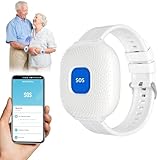Key Takeaways: Can I Get a Free Personal Alarm?
Limited Free Options: While some organisations and charities offer free personal alarms, availability may be restricted to specific groups, such as the elderly or people with disabilities.
How to Obtain a Free Personal Alarm: Look for potential free personal alarms at community agencies or national campaigns and charity events.
Consider the Pros and Cons: Free personal alarms are a cost-effective safety option, but they may lack the robustness of paid alternatives. Weigh the benefits and drawbacks to determine the best choice for your needs.
Top Personal Alarms
Many individuals are interested in discovering whether free personal alarms are available since they believe they are an excellent tool for guaranteeing safety and security. There are several shops where you can buy personal alarms. In this article, we’ll discuss the numerous methods by which a person might get a personal alarm and the benefits and drawbacks of each approach.
What Is A Personal Alarm?
A personal alarm is a portable device you might call to sound an alert in an emergency. A digital personal alarm offers enhanced connectivity and emergency communication, featuring waterproof design for use in bathrooms, the ability to communicate with an Emergency Resolution Team, and multi-network SIM cards for reliability. It generates a loud, attention-grabbing sound that may make others aware of your predicament and aid in your escape from harm. Personal alarms are often carried in a handbag or pocket or worn as a necklace around the neck.
Types of Personal Alarms
Personal alarms are designed to provide peace of mind and reassurance for individuals, particularly the elderly, who want to maintain their independence while having access to help when needed. There are various types of personal alarms available, each with its unique features and benefits.
Basic Alarm
A basic alarm is a simple and cost-effective solution for personal safety. It works by sounding a loud noise when a button is pressed on the device, alerting people nearby that assistance is needed. Basic alarms are available for purchase from various retailers and online marketplaces, and they can be purchased for around £10. They are a great option for those who want a simple and affordable solution for personal safety.
Pendant Alarm
A pendant alarm is a type of personal alarm that connects the elderly and vulnerable with an emergency response centre. It provides 24-hour monitoring and response to falls, accidents, and other emergencies. Pendant alarms require a base unit in the home and a pendant device worn by the user. The pendant device can be pressed to alert the emergency response centre, and some pendant alarms allow users to speak directly to the response centre. Pendant alarms require a monthly or annual subscription for monitoring services, and setup fees start at around £35.
GPS Tracking Alarms
GPS tracking alarms use satellite technology to track the user’s location. They can pinpoint the location of elderly or vulnerable individuals anywhere in the world. GPS tracking alarms often come with a panic or SOS button for emergency assistance. They require an initial setup fee and a monthly subscription, and the cheapest GPS trackers start at around £135 per year.
In summary, personal alarms come in various forms, including basic alarms, pendant alarms, fall detectors, and GPS tracking alarms. Each type of alarm has its unique features and benefits, and they can provide peace of mind and reassurance for individuals who want to maintain their independence while having access to help when needed.
Who Needs a Personal Alarm?
Thanks to personal alarms, everyone may feel safer and more protected, but those who may already be at risk, such as older people, those with impairments, and women, may find them especially helpful. An elderly personal alarm, particularly with features like automatic fall detection, is crucial for seniors to live independently and safely at home.
Are There Free Personal Alarms Available?
Some organisations and charities provide free personal alarms to people who need them. However, these options are often limited and may only be available to specific groups, such as older people or people with disabilities.
How to Get a Free Personal Alarm
There are several places you may go to get a free individual alarm:
- See if a community agency or municipality in your area gives out free personal alarms by contacting them. Councils provide monitoring services for personal alarms, but the availability and quality of these services can vary significantly.
- Make contact with shelters for women and persons with disabilities, as well as other groups that assist those in need who are in vulnerable situations.
- Personal alarms may be given out as a promotion by national campaigns or at charity events.
Pros and Cons of Free Personal Alarms
A free personal alarm is a terrific way to ensure your safety without spending money. Free personal alarms are often classified as basic systems, which typically lack advanced features and functionalities. Those who cannot afford one alone may greatly benefit from one.
However, a downside to using a free personal alarm is that it may not be as robust or dependable as a paid one. Discovering a free alarm that meets your demands may be challenging since their number is likely small.
Summary Of Can I Get A Free Personal Alarm
While obtaining a free personal alarm is possible, there may be limited options. Many councils do not offer alarms for free, and the typical process of obtaining personal alarm services often requires a home assessment to identify safety risks. Many organisations and charities provide personal alarms, but availability may be limited. It’s important to weigh the pros and cons of a free alarm and consider whether it’s the best option for your needs. If you cannot find a free alarm, consider purchasing one from a reputable supplier to ensure it is reliable and effective in an emergency.
Top Personal Alarms
Explore More Personal Alarm Options and Safety Solutions
- Best Personal Alarms for the Elderly – Discover a range of personal alarms designed to enhance safety and independence for seniors.
- How Personal Alarms Work – Learn how personal alarms function to provide peace of mind in case of emergencies.
- Best Fall Detection Alarms – Find alarms with fall detection features to alert loved ones or caregivers in case of an emergency.
- Best Mobile Personal Safety Apps – Explore mobile apps that offer personal safety features, including emergency alerts and tracking.
- Best Mobile Alarms – Understand the benefits of mobile alarms equipped with GPS, which provide emergency assistance and allow tracking of the wearer, offering reassurance to family members and aiding in the care of vulnerable individuals.






